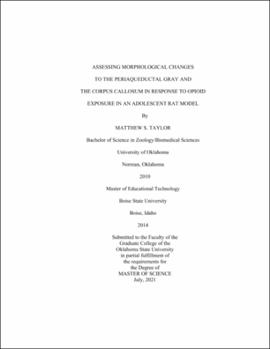| dc.contributor.advisor | O'Brien, Haley D. | |
| dc.contributor.author | Taylor, Matthew S. | |
| dc.date.accessioned | 2023-09-21T18:57:24Z | |
| dc.date.available | 2023-09-21T18:57:24Z | |
| dc.date.issued | 2021-07 | |
| dc.identifier.uri | https://hdl.handle.net/11244/339606 | |
| dc.description.abstract | The risk-taking behavior that occurs during adolescence, as well as the brain development that coincides with this period, makes adolescents vulnerable to trying and becoming addicted to drugs of abuse, such as opioids. Drug addiction causes changes to the brain at the chemical scale (triggering or inhibiting neurotransmitter release), the cellular scale (strengthening or weakening neural connections), and at the gross anatomical scale (i.e., changes detected on brain scans). The goals of this investigation are to 1) refine gross neuroanatomical imaging techniques and 2) apply the techniques to a rat model of adolescent opioid addiction. I used a nascent soft-tissue imaging technique called diceCT (diffusible iodine-based contrast-enhanced computed tomography), which allowed me to digitally analyze small neuroanatomical structures without dissection. First, I tested the efficacy of two diceCT protocols: the standard approach of fixation, staining, and scanning specimens, and another approach that adds a tissue-stabilization step, which is reported to limit the tissue shrinkage that can occur when a specimen is exposed to high concentrations of iodine. MicroCT visualizations from this experiment revealed that tissue stabilization is not routinely necessary to obtain satisfactory brain scans, as elliptical Fourier analysis found no significant shape differences when neuroanatomical structures were compared between stabilized and non-stabilized brains. Then, for a second experiment, I used the same adolescent rat brains to determine if opioid exposures during life can be associated with gross anatomical changes to the periaqueductal gray (PAG) and corpus callosum. I found highly significant changes to the cross-sectional shape of both the PAG and the corpus callosum in the opioid-exposed group compared to the drug-naïve group. Whether these anatomical changes translate into functional or behavioral consequences should be the target of future investigations. Potential limitations to this experiment are the low sample size (n = 18) and the complicated design of drug exposures. While further research is necessary to overcome these limitations, the implications of this preliminary investigation are troubling, especially given adolescents’ increasing access to opioids. | |
| dc.format | application/pdf | |
| dc.language | en_US | |
| dc.rights | Copyright is held by the author who has granted the Oklahoma State University Library the non-exclusive right to share this material in its institutional repository. Contact Digital Library Services at lib-dls@okstate.edu or 405-744-9161 for the permission policy on the use, reproduction or distribution of this material. | |
| dc.title | Assessing morphological changes to the periaqueductal gray and the corpus callosum in response to opioid exposure in an adolescent rat model | |
| dc.contributor.committeeMember | Vazquez Sanroman, Dolores | |
| dc.contributor.committeeMember | Curtis, Kathleen | |
| osu.filename | Taylor_okstate_0664M_17257.pdf | |
| osu.accesstype | Open Access | |
| dc.type.genre | Thesis | |
| dc.type.material | Text | |
| dc.subject.keywords | addiction | |
| dc.subject.keywords | diceCT | |
| dc.subject.keywords | elliptical Fourier analysis | |
| dc.subject.keywords | morphometry | |
| dc.subject.keywords | neuroimaging | |
| dc.subject.keywords | opioids | |
| thesis.degree.discipline | Biomedical Sciences | |
| thesis.degree.grantor | Oklahoma State University | |
